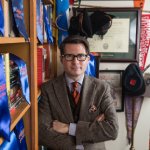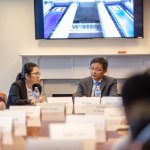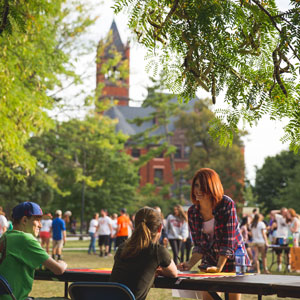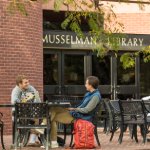
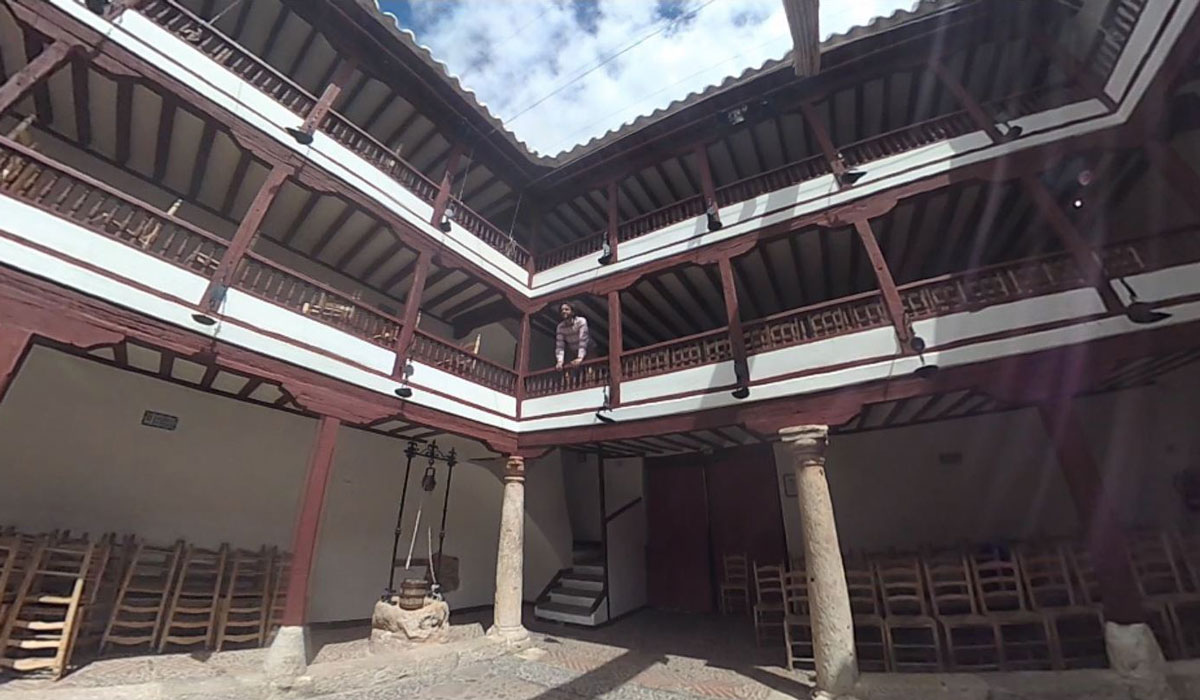
Creative innovation and collaboration are two striking assets of a Gettysburg College education. Imaginative minds converge at the Innovation and Creativity Lab, where students and faculty alike uncover groundbreaking possibilities and give rise to insightful inventions.
Thanks to a cross-disciplinary approach, Spanish Prof. Christopher Oechler was able to construct a virtual reality rendering of Madrid’s El Corral de Príncipe, setting the stage for his students to experience a 17th-century theatrical space through a modern lens.
Along with a team of Digital Technology Summer Fellows, Oechler used computer graphic software to make the historical Spanish theater accessible to his language students. In his classroom, he proves that both time travel and technological exploration are possible with careful research, critical thinking, and successful collaboration.
The curtains rise and the spotlight shines on Oechler in this Q&A as he provides a behind-the-scenes look at the virtual reality technology from its inception to execution.
What inspired you to work on this project?
“In my field of Golden Age Spanish theater during the 16th and 17th centuries, we have begun to consider plays not only as literature but also as dramatic works. When it comes to historical performance, though, we’re at a disadvantage—the theaters no longer exist. When I saw a presentation on virtual reality during a Friday Forum, [which is a faculty and staff lecture series on scholarly research], I immediately recognized the technology as a powerful tool to overcome this challenge by allowing us to recreate the theatrical space of El Corral del Príncipe as theatergoers in Madrid would have experienced it during the early modern period.”
Virtual reality—it’s all in the name. Nothing you see in the goggles is real. It’s a virtual recreation. But you have a genuine experience in that virtual space.”
How can virtual reality give us a new and unique glimpse into history?
“Instead of looking at a two-dimensional drawing or manipulating a three-dimensional scaled model, you experience the historical building in all its dimensions, as you would in reality. You can navigate through the space, and, in the case of the theater, view the stage from different seats to explore sightlines, listen to how sound carries in different areas, witness how sunlight diffuses through the canopy covering the yard and illuminates the stage, and finally, take a seat to watch how acting troupes would have performed their craft.”
How did you approach the initial stage of research?
“The first step in my project was to consult the existing studies on this playhouse. Luckily, two scholars, John J. Allen and José María Ruano de la Haza, have published lengthy studies on the Príncipe. Only one drawing exists of the theater, of which I was able to procure a copy from an archive in Madrid. Using the studies and the drawing as my guides, I began to design the theater.”
What did the design process entail?
“Interestingly enough, the design process really became a conversation between scholarship and technology. In the virtual space, I would find that specific measurements or thoughts on layout from the scholarship would not work, so I would return to my research, studies on the theater and period architecture in general, and even to archival sources—mostly repair documents—to get a better understanding of the geometric possibilities. Armed with that knowledge, I would return to the model and repeat the process until I was satisfied.”
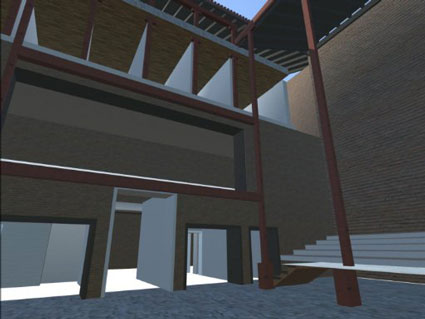
How did you combine the design team’s expertise with your historical knowledge?
“Working with the students taught me more about managing a successful group workflow. In this case, the students brought their technical knowledge to the project and helped me build a model that resembled my vision. The students have taught me quite a bit about the primary software that we are using, Blender and Unity. Currently, I am tweaking the geometric model in Blender, while I rely on the students’ expertise to bring the model into the virtual reality world with textures, natural lighting effects, and movement capabilities.”
What did your students learn while collaborating with you on this project?
“I hope that the students I have worked with come away with an appreciation for the digital humanities and the steps that go into working on a project of such magnitude. One thing I have tried to teach them is the importance of critical reflection. With their skills, students would have been able to complete the entire project in less than a week. Historical reconstruction, however, requires that you build to the best of your knowledge, assess, and rebuild following a critical evaluation of the model. This process can repeat ad nauseam, which I am sure the students can confirm. To do it right, though, we must reflect critically on what we do and how we do it.”
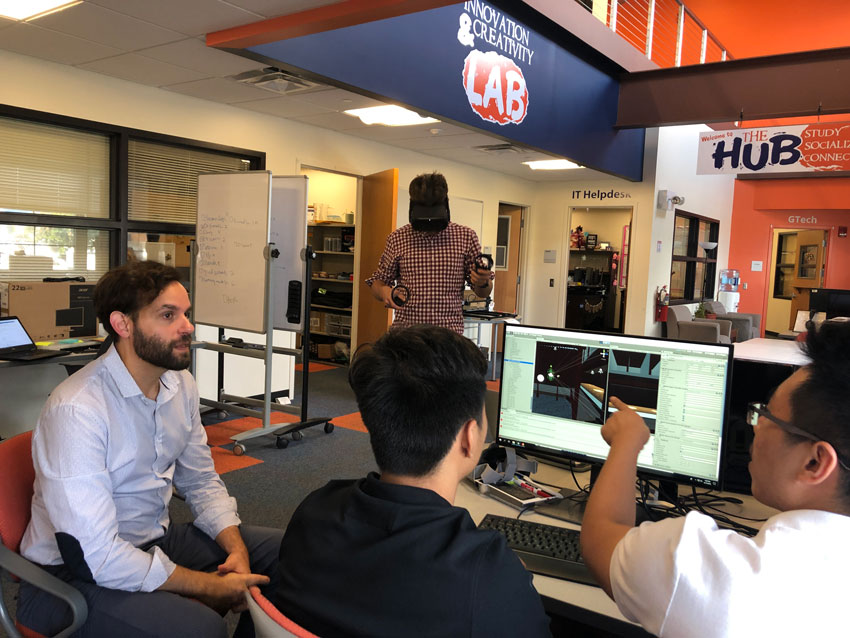
Photo by R.C. Miessler
How does this innovative technology enhance your teaching?
“The model gives students a sense of space and encourages them to match the play that we are reading with real-life performance possibilities. This in turn allows me to get creative with the projects that I assign students. Instead of writing the typical term paper on a specific scene or theme in the play, students will be able to act as the director, or autor/a de comedias [when translated to Spanish], and stage a specific scene, while justifying their understanding of the text, its contexts, and their analytical choices in terms of the play and the theater space. My goal is to utilize the technology in a dynamic way, so that students engage with the class and the material on a whole new level. In the coming year, I will work on refining the model further and adding animated stage effects.”
Project Contributors (past and present):
- Hoang Anh Just, ’21, 2018 Digital Technology Summer Fellow
- Michael Bloom, IT Intern
- Thomas H. Mendola ’20, 2019 Digital Technology Summer Fellow
- R.C. Miessler, Systems Librarian
- Minh D. Nguyen, ’21, 2019 Digital Technology Summer Fellow
- Eric Remy, Director of Educational Technology
- Orrin Wilson, ’20, 2018 Digital Technology Summer Fellow
By Phoebe Doscher ’22
Photos courtesy of Christopher Oechler
Posted: 09/25/19
